

Breakout rooms generally available today in Microsoft Teams. Creating meaningful connection can be difficult in larger group settings.
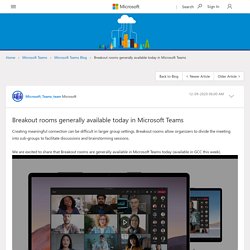
Breakout rooms allow organizers to divide the meeting into sub-groups to facilitate discussions and brainstorming sessions. We are excited to share that Breakout rooms are generally available in Microsoft Teams today (available in GCC this week). The meeting organizer can create up to 50 breakout rooms and choose to automatically or manually assign participants into rooms.
The organizer can start a breakout room in a Teams meeting or a Teams channel meeting, allowing greater flexibility on how you want to meet. Using the breakout room settings, the meeting organizer can choose to allow participants to come back to the main meeting at any time, then return to the assigned breakout room. Also, organizers can use the setting to re-create breakout rooms in the same meeting. The meeting organizer can create, rename, and delete rooms as needed. FAQWho can start a breakout room? Remove Background from Image – remove.bg. 7 Ways to Do Formative Assessments in Your Virtual Classroom. Pen-and-paper pop quizzes are no more: thumbs-up/thumbs-down, hand signals, online polls, discussion boards, and chat boxes have become the new mainstays of formative assessments in virtual classrooms.

These quick pulse checks help teachers make sure that students are grasping key concepts—and identify holes in their understanding. “Good teachers in every subject will adjust their teaching based on what students know at each point,” says Vicki Davis, a director of instructional technology in Albany, Georgia, underscoring how crucial ongoing formative assessments are in the classroom. Teachers don’t need to completely reinvent their traditional formative assessments, however, according to Mike Anderson, an educational consultant in Durham, New Hampshire.
He recommends that teachers modify familiar practices—like exit tickets and think-pair-shares—so they work virtually. “In our distance learning environment, we run the risk of being further isolated. 1. Seeking and sending signals - PESA Agora. Allison Littlejohn UCL Knowledge Lab, University College London, London, UK Abstract With the increased use of online teaching during the Covid-19 crisis, technology-mediated interactions have become central to the co-constructive nature of learning in universities.

This research questions the efficacy of online teaching as it has been implemented during the crisis by examining critical forms of online interaction. 5 essential Zoom hacks to improve your virtual hangouts. Teaching on Zoom: Breaking (Out) Bad? Try these 7 tips… – Lee Donaghy. On Sunday I replied to a short Twitter conversation about most of the conversation in Zoom break out rooms being about being in a Zoom break out room with the following thread of tips for making sure most of the conversation in Zoom break out rooms is not about being in a Zoom break out room: I certainly know the feeling of time in a break out room not being used effectively, but as with all good teaching there are things we can do to reduce the likelihood of this and to maximise the effectiveness of break outs – we simply have to take the principles we know would work well in-person and apply them to online mode, taking advantage of the capabilities of Zoom as a platform.

I do all of my teaching of trainee and early career teachers on Zoom these days, so have had plenty of practice, and so I thought fleshing out the 7 tips I tweeted might be useful for those who use the platform for their teaching/training/development sessions with teachers. 1. Keep timing tight. 2. Classroom Observation - An Interview with Matt O'Leary — The Teaching Space. Universal Design for Learning. Universal Design for Learning (UDL) is a framework developed by CAST, an Understood founding partner.

UDL guides the design of learning experiences to proactively meet the needs of all learners. When you use UDL, you assume that barriers to learning are in the design of the environment, not in the student. UDL is based on brain science and evidence-based educational practices. It also leverages the power of digital technology. Imagine this: Your students are going to write an essay on the stages of butterfly metamorphosis.
Some students have seen butterflies grow through the different stages at a local science museum. In any class, you know there’s a wide range of enthusiasm, background, and skills among your students. Naace: eGuides. Naace publishes a series of publications, developed to address the ongoing needs of schools – the Naace eGuides.
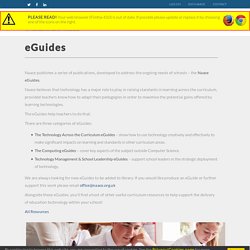
Naace believes that technology has a major role to play in raising standards in learning across the curriculum, provided teachers know how to adapt their pedagogies in order to maximise the potential gains offered by learning technologies. The eGuides help teachers to do that. How to make video calls almost as good as face-to-face. Communities of Practice Project. Jitsi.org - develop and deploy full-featured video conferencing. Twitter. How to teach from the front of class. Regardless of our approaches to pedagogy and thoughts about how we "should" be teaching, what we do in the classroom is likely to be very different this term.

In many schools, teachers will be required to maintain two metres of distance from students, or even stay in a specified area at the front of the classroom. This limits chances to move around the room, offer one-to-one guidance, strategically place oneself as a behaviour-management device, and give immediate feedback – all of which are part of the daily routines of effective teachers.
Suddenly, these tools are being pulled out from under our feet. Yes, of course, we need to remain at a safe distance from each other. I am not complaining about such measures. A few years ago, I broke three bones in my foot. 1. SEDA - COVID-19 Assessment Collection. Kay Sambell and Sally Brown In August 2020, Kay Sambell and Sally Brown wrote the fourth in their series of blog papers on the relationship between the Covid-19 crisis and assessment in higher education and very kindly offered it to SEDA to publish.
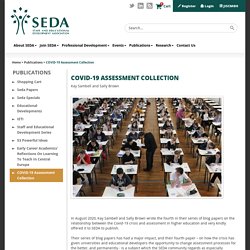
Their series of blog papers has had a major impact, and their fourth paper – on how the crisis has given universities and educational developers the opportunity to change assessment processes for the better, and permanently - is a subject which the SEDA community regards as especially important. Having been leading players in helping universities and their staff to steer their way at high speed through the recent upheavals, the challenge for educational developers now is how to ensure that our students have the best possible learning experience in the next phases of change. Assessment reform is central to that work. How Assessment is Changing in The Digital Age - Five Guiding Principles. Preparing assessments in the context of pandemic – lydiaarnold.net.
There has been some excellent new work on assessment and feedback in recent months, including the freely available ‘On Your Marks: Learner-Focused Feedback Practices and Feedback Literacies’ and new resources and ideas from Professors Kay Sambell and Sally Brown.
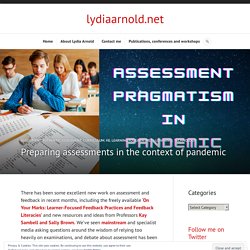
We’ve seen mainstream and specialist media asking questions around the wisdom of relying too heavily on examinations, and debate about assessment has been played out across society – I heard it going on between parents in the fridge aisle of the local supermarket. Working closely with staff and students over the last six months has prompted me to consider which assessment principles should be foregrounded to assist in the context of COVID. It’s more important than ever that our assessment approaches are practical, manageable and flexible in light of the operational reality i.e. in the context of inconsistent attendance due to students isolating, possible lockdowns, and short-notice switches in the mode of teaching. Stein, S. Lessons from Stanford University's move to remote learning.
Bliss, C. (2020) Stanford makes strides to improve online learning in pandemic environment, Stanford News, August 17 Stanford University received responses from 6,000 of their students (response rate just under 40%) to identify the main obstacles students encountered during the spring quarter, when it moved its classes to remote learning.
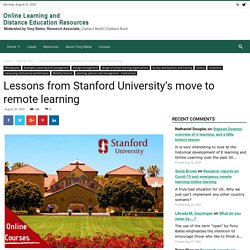
The article describes not only the main issues that needed to be addressed as a result of the survey responses, but the steps it has taken to mitigate these for the upcoming fall quarter (semester), since undergraduates will not be on campus in the fall. Although Stanford is not a typical university – through its endowments, it is one of the wealthiest universities in the world – there are nevertheless important lessons for the fall semester that will apply to many other higher education institutions. Main results nearly 80 percent of all students indicated difficulty with focusing on online instruction. Main adjustments Comment Also, it needs extra money. Awesome Assessment with Flipgrid. Flipgrid has added some amazing new features! I am most excited about the new split screen option when recording a response.
Video Assessment As a math teacher, show your work is obsolete. Photomath will do that! I want “Show your thinking.” Create a Group Flipgrid has changed the interface and some of the terminology. Pedagogy and Technology from a Postdigital Perspective – Teaching Matters blog. In this post, Deputy Programme Director of the MSc in Clinical Education and part-time tutor on the MSc in Digital Education Tim Fawns describes a postdigital view of pedagogy and technology in which technology and digital “things” are seen as always connected to the settings, people and practices in which they are situated… (Thanks to Gill Aitken, Derek Jones and Michael Gallagher for their input to this post).
I have heard lots of colleagues over the years say that pedagogy should drive technology, rather than vice versa. This is neatly illustrated by Michael Sankey’s image of the horse of pedagogy driving the cart of technology. However, for me, this is a false dichotomy. Twitter. English and Maths: Sites, Apps and interactive resources. Organize your inner universe.
7 Unique Ways to Enhance Windows 10 With Microsoft PowerToys. Microsoft launched the initial version of PowerToys for Windows 95 to give power users improved productivity and customization features. It returned for Windows XP but wasn’t seen again until 2019, when the newest flavor of PowerToys was made available for Windows 10. Digital strategy in an age of remote learning. A free guide to creating a digital strategy for your school has been updated and republished taking into account the new landscape of remote learning. It has been written by SecEd editorial board member Al Kingsley, who is chair of a multi-academy trust and MD of ed-tech company NetSupport, and ICT expert and former school leader Mark Anderson.
The guide considers the purposeful use of technology, its links to pedagogy, IT infrastructure, finance and budgets, SEND, safeguarding, working with governors and a number of other areas. New additions to the guide in light of the Covid-19 pandemic and the national lockdown include information and advice on the challenges and solutions to remote teaching and learning. A new section on communication and collaboration also looks at using video communication tools and provides guidelines for children, parents, teachers and schools on how to get the best out of them. Further information & resources. Feedback is the lubricating oil of teaching and learning. Yet feedback in online learning – is its mostly absent... In this age of Covid-induced, online learning, people have rushed to Zoom, recorded videos and content that, far from being Blended Learning, is Blended Teaching.
To be fair, some effort is made to get learners to do effortful learning, usually multiple choice questions or tasks which are returned to the teacher or lecturer. Unless you already have a good platform and have been doing this for some time in something like Teams or Google Education, what is so often missing is good FEEDBACK. More details on what's coming to Meet and Classroom. Spot missed citations with enhanced originality reports Originality reports, which are built into Classroom and Assignments, provide educators with flags for potential plagiarism in student work and also help students quickly identify passages that may need citations. Now, we’re making originality reports even more helpful. First, we’re raising the number of originality reports that educators can use per class from three to five.
Teacher Hacks. Thread by @kasal_finley: Processing today: I took 2 fully online APSI courses this summer. Here are my takeaways as it relates to being a "student" in an online clas… 3 Ways to Use Video Conferencing with Students Learning Remotely. Need support preparing for fall? Teaching from Home: Some Technical Advice — Mikio Akagi. As an instructor, it is probably advisable to use video, if possible (the main exception being if many of your students lack access to high-speed internet). Again, there are accessibility considerations—it is easier for your students to understand what you say if they can see your mouth when you speak. Virtual Back to School Ideas □ Teachers have been let down by a decade of inaction on digital technologies. Terry's top ten tips for tutors using Zoom. Diana-laurillard-six-learning types. Online education in further education and skills: learning about what works - Ofsted blog: schools, early years, further education and skills.
Paul Joyce, Deputy Director for Further Education and Skills, talks about our review into online education during coronavirus (COVID-19) in the further education and skills (FES) sector. Lost in translation - eLearning Stuff. Commercialisation and privatisation in/of education in the context of Covid-19 by Education International. "Catch-up" and recovery approaches: Selected reading. Introduction. Meet features help engage students and moderate classes. Twitter. Google Chrome’s Link to Text Fragment extension – Top Tools for Learning. A recent article in MakeUseOf, You can now link to specific text on a website explains “If you have ever wanted to share an article with someone but direct them to a specific part, you’ll love Google’s new Chrome extension. Home - Classroomscreen. Abardo. Online college? good idea; but is it the beginning of the end? Create better lessons quicker.
Teaching about mental wellbeing. This training module supports the physical health and mental wellbeing section of the statutory relationships, sex and health education curriculum. This is the first of a series of 14 modules to support schools to implement the new curriculum. We have developed this mental wellbeing teacher training module to help subject leads and teachers understand what they should teach, as well as improving their confidence in delivering mental wellbeing as part of the new curriculum.
Fears, hopes and reimaginings: learning and teaching within, through and beyond the pandemic. 7 Things You Should Know About the HyFlex Course Model. HyFlex Course Design Model with Brian Beatty. OliCav. Moodle. If we can't all be the OU by September, what can we become? Field Notes on Pandemic Teaching: 5. Thinking about Pedagogy in an Unfolding Pandemic An Independent Report on Approaches to Distance Learning During COVID19 School Closures.
Gathering information about how well pupils are learning at home is crucial right now. Use these steps from research ⬇️□ IDDblog: Instructional Design Tips, Advice, & Trends for Online & Distance Learning. New podcast on the future of online learning and higher education post-Covid 19. 7 new features on Prezi Video to support online learning. 5 Teaching Strategies of Award-Winning Online Instructors. Remote learning: lessons learned. Inspired by my appearance on last weeks #CovidEduStories with @ICTEvangelist and @rondelle10_b , and hearing from @JulesDaulby here is my video guide to setting up the spoken content #Accessibility functions on iOS devices #edtech. Open Broadcaster Software. Ally for LMS. Universities' move online 'must be done the right way' Create a Choice Board from Bingo Add-on.
10. A consistent, mission-aligned instructional framework for the fall and beyond (opinion) How Coronavirus Will Disrupt Future Colleges & Universities. Future skills: how our innovators are transforming online adult learning. Free Screen & Video Recording Software. Five Ways to Make Review Games for Students to Play at Home. Guidelines on Distance Education during COVID-19. Three Ways to Convert Video into Audio. Digital by default: the new normal of family life under COVID-19. Neil Mosley sur Twitter : "Back in March I shared 8 tips for the switch to remote teaching, equally applicable for those thinking about online teaching in the future. Here they all are in one place - feel free to share and use #onlinelearning… (59) How to use the Immersive Reader in Microsoft Word for web.
Using iPad as separate whiteboard in Teams - Tech Stuff. Microsoft now at 75 million daily active Teams users despite supply chain constraints affecting its cloud business. ResearchEDHome 2020 Paul Kirschner: Ten Tips for Emergency Remote Teaching. Thread by @head_teach: Here are seven erroneous assumptions in calling for universal all-day synchronous online teaching: Assumption 1: That all aspects of normal… Film Competition 2020. E-books for FE. Parental load theory – Becky Allen. Arts & Culture. Artefacts of practice; learning in lockdown. Functional Skills - England - BBC Bitesize. The best on-line teaching tool is kindness. Designing learning and teaching online: the role of discussion forums. Ten top tips for using Zoom for programme delivery. Consistency and scaffolding in online education – UCEM Online Education.
The Difference Between Emergency Remote Teaching and Online Learning. BBC Radio 4 - The Learning Revolution. How Wakelet can transform the classroom for teachers and students. #TeachFromHome - Twitter Search / Twitter. (43) Storytelling with Google Earth Projects. Create learning which follows Rosenshine's 10 principles of effective Instruction. Original research paper here. Webinars, online classes and meetings – from Yawn to Yay - Responding to Coronavirus. Supporting Student Learning Online - Learning and Teaching academy.